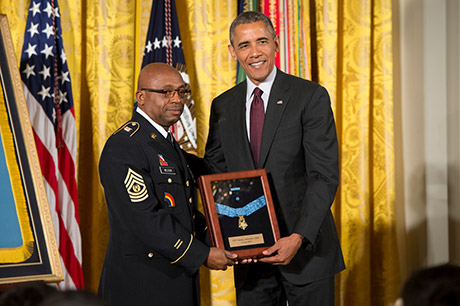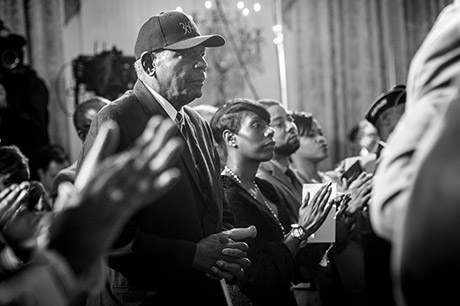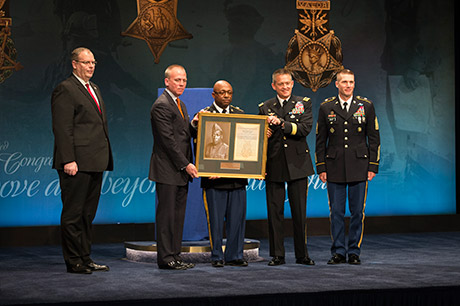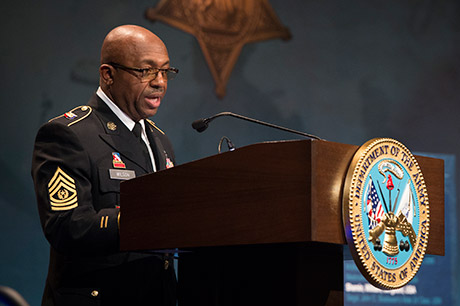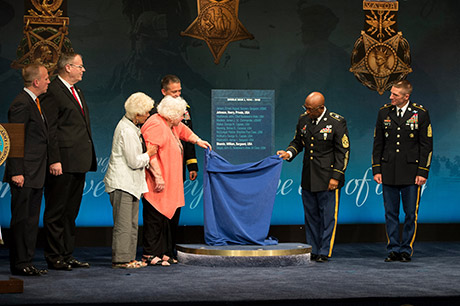Sergeant Henry Johnson
- born
- Abt. July 15, 1892
- hometown
- Winston Salem, North Carolina
- enlistment date
- June 5, 1917
- branch
- Infantry
- unit at time of action
- 369th U.S. Infantry Regiment
- tours of duty
- World War I, France, 1918-1919
Born William Henry Johnson in Winston Salem, North Carolina, Johnson moved to New York as a teenager. He worked various jobs - as a chauffeur, soda mixer, laborer in a coal yard, and a redcap porter at Albany's Union Station. He enlisted in the U.S. Army, June 5, 1917, and was assigned to Company C, 15th New York (Colored) Infantry Regiment - an all-black National Guard unit that would later become the 369th Infantry Regiment.
The 369th Infantry Regiment was ordered into battle in 1918, and Johnson and his unit were brigaded with a French army colonial unit in front-line combat. Johnson served one tour of duty to the western edge of the Argonne Forest in France's Champagne region, from 1918-1919.
For his battlefield valor, Johnson became one of the first Americans to be awarded the French Croix de Guerre avec Palme, France's highest award for valor.
Johnson returned home from his tour and was unable to return to his pre-war porter position due to the severity of his 21 combat injuries. Johnson died in July 1929. He is buried in Arlington National Cemetery in Arlington, Virginia.
Johnson was posthumously awarded the Purple Heart in 1996 and the Distinguished Service Cross in 2002.

Sgt. Henry Johnson of the 369th Infantry Regiment was awarded the French Croix de Guerre for bravery during an outnumbered battle with German soldiers, Feb. 12, 1919. (Photo: Public Domain)

Sgt. Henry Johnson is "one of the five bravest American soldiers in the war."
Theodore Roosevelt Jr. in his book "Rank and File: True Stories of the Great War"
Battle Narrative
- Area of Operation
- Argonne Forest, Champagne, France
- position
- Sentry
- Date of Action
- May 15, 1918
Then-Pvt. Henry Johnson served as a member of Company C, 369th Infantry Regiment, 93rd Division, American Expeditionary Forces, during combat operations against the enemy on the front lines of the Western Front in France.
While on night sentry duty, May 15, 1918, Johnson and a fellow Soldier, Pvt. Needham Roberts, received a surprise attack by a German raiding party consisting of at least 12 soldiers.
While under intense enemy fire and despite receiving significant wounds, Johnson mounted a brave retaliation resulting in several enemy casualties. When his fellow Soldier was badly wounded, Johnson prevented him from being taken prisoner by German forces.
Johnson exposed himself to grave danger by advancing from his position to engage an enemy soldier in hand-to-hand combat. Wielding only a knife and being seriously wounded, Johnson continued fighting, took his Bolo knife and stabbed it through an enemy soldier's head.
Displaying great courage, Johnson held back the enemy force until they retreated. The enemy raid's failure to secure prisoners was due to the bravery and resistance of Johnson and his fellow comrade. The effect of their fierce fighting resulted in the increased vigilance and confidence of the 369th Infantry Regiment.

Our Colored Heroes
The "Our Colored Heroes" lithograph, published by E.G. Renesch in 1918, depicts the German raid on then-Pvt. Henry Johnson and Pvt. Needham Roberts during World War I. The lithograph quotes Gen. Pershing, who praises the two African American sentries, who "continued fighting after receiving wounds and despite the use of grenades by a superior force." (Image courtesy of the Tennessee State Library and Archives)
The 369th Infantry Regiment
“Harlem Hellfighters”
The “Harlem Hellfighters“ were the first all-black regiment that helped change the American public's opinion on African-American Soldiers and helped pave the way for future African-American Soldiers.
The 369th Infantry was originally formed in 1913 as the 15th Infantry Regiment in the New York Army National Guard. The infantry was one of the first few Army regiments to have black officers in addition to an all-black enlisted corps, and was one of the few black combat units during World War I. Reflecting racial discrimination and segregation both in American society and within the Army, American Expeditionary Forces leadership avoided placing African-American units alongside of white Army units. As a result, Gen. John J. Pershing, commander of the American Expeditionary Forces, assigned the 369th Infantry to attach with the allied French Army.
During its service during World War I, the regiment is credited with participation in the Champagne-Marne, Meuse Argonne, Champagne 1918, and Alsace 1918 campaigns.
The 369th Infantry Soldiers, nicknamed the "Harlem Hellfighters", spent 191 days in the front line trenches and earned a regimental French Croix de Guerre with Silver Star and Streamer embroidered Meuse-Argonne, and more than 170 Croix de Guerre medals during World War I.
The 369th Infantry's regimental band, under the direction of Lt. James Reese Europe, is credited with introducing jazz music to European audiences.

Distinctive Unit Insignia
This distinctive unit insignia was originally approved, April 17, 1923. The rattlesnake is a symbol used on some colonial flags and is associated with the 13 original colonies. Its coiled, ready-to-strike position alludes to the service of the organization during World War I.
DID YOU KNOW?

